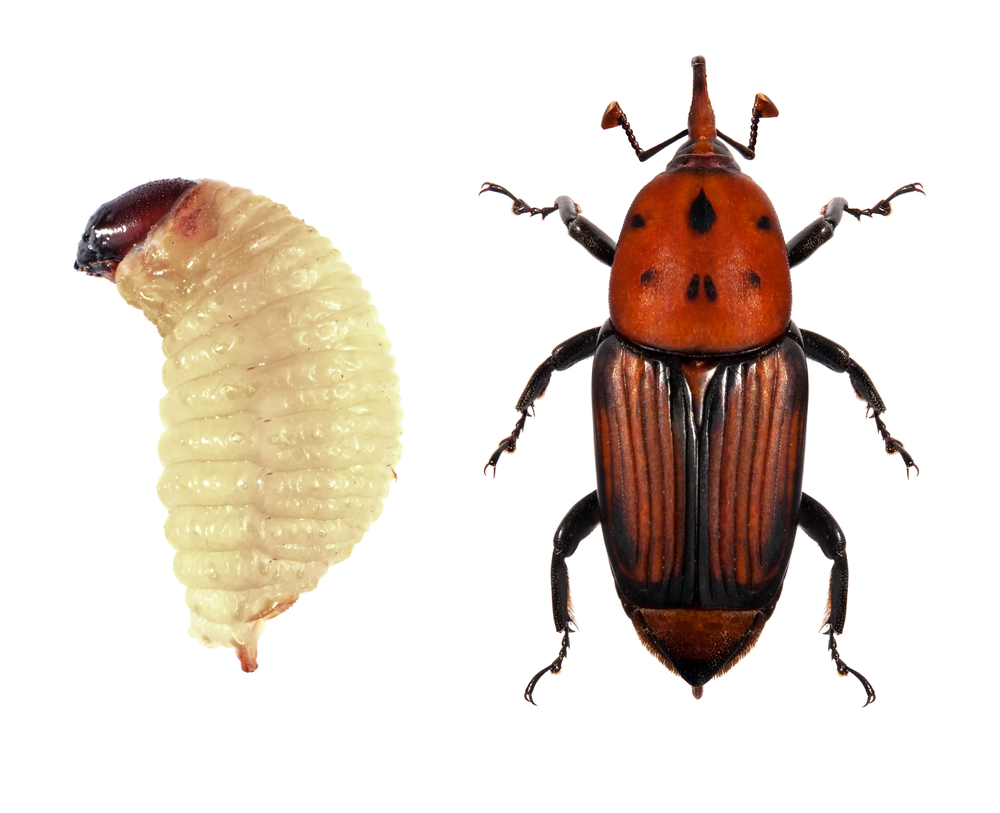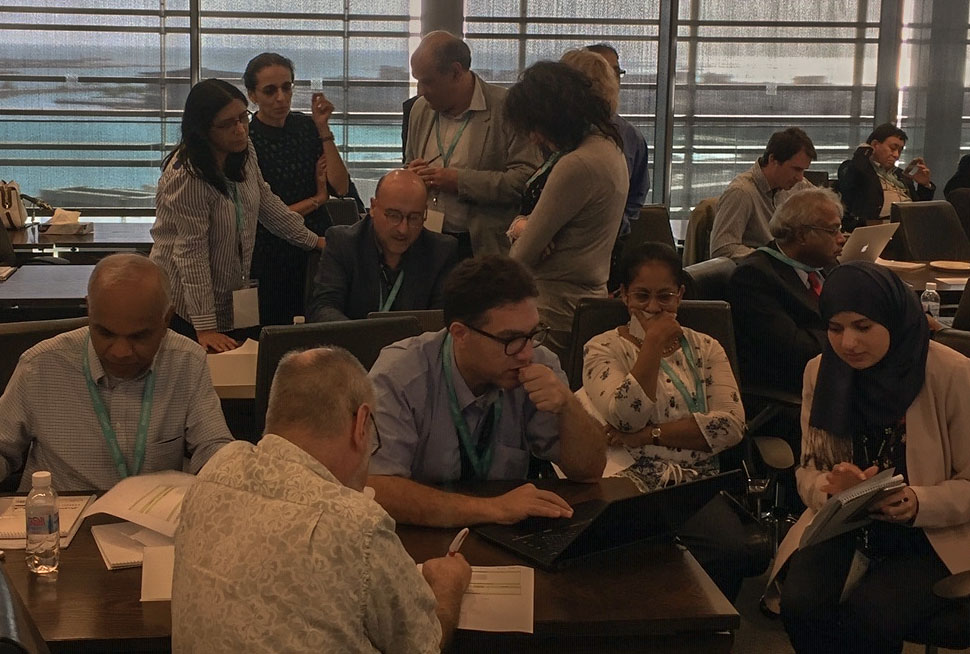Using sensor technology to tackle red palm weevils

Pictured here is a red palm weevil larva (left) and one at maturity (right). The weevil larvae spend their entire four-month life cycle within a palm tree's trunk. File photo.
-By Meres J. Weche, KAUST News
The red palm weevil (Rhynchophorus ferrugineus) is a snout beetle insect originating from tropical Asia. Over the last few decades, it has spread to a large part of the Middle East, North Africa and virtually the entire Mediterranean region. Weevil larvae, the insects at their stage of development from an egg to before their adult form, are the cause of severe and widespread damage to certain palm tree species.
The weevil larvae spend their entire four-month life cycle within the palm tree's trunk, hollowing it out from the inside until the tree dies. They are considered the most destructive pest of palms in plantations worldwide—including for coconut palms, date palms and oil palms. Controlling the spread and pernicious effects of red palm weevils is important because date farming and crops represent an important economic activity and resource for Saudi Arabia and the region.
"Governments from many countries are committing to serious funding to tackle this plague. Palm production represents a big industry. Red palm weevils have wiped out a whole generation of trees in many countries like Malaysia, Indonesia and Spain, so [they're] a very severe problem," KAUST Professor Khaled Nabil Salama explained.
.jpg)
Pictured here is a close-up of the head of the red palm weevil. The insect uses its pair of antennae and its long proboscis (nose) to detect chemical cues in the environment, such as pheromones sent by other red palm weevils. File photo.
The importance of early detection
In an effort to tackle this natural challenge, the Saudi Ministry of Environment, Water & Agriculture (MEWA) contacted KAUST to investigate new ways of detecting the red palm weevil threat at an early stage.
"When the trees are showing visible signs of distress such as a sagging canopy, it generally means that the [red palm weevil] infection is well-advanced and the likelihood of rescuing the tree very low", Dr. Anne-Françoise Lamblin, manager in the KAUST Office of Sponsored Research (OSR), pointed out. The goal is to detect the insects' presence at the earliest contagion stage possible to treat and rescue the tree.
"Everyone is trying now to solve the problem by various early detection methods," Salama noted.
The main difficulty of the problem is that the whole disease takes place inside the tree. Therefore, early detection methods focus on finding out if weevils are resident inside the tree so experts can take appropriate action and eliminate them before they kill the tree.
OSR has hosted conferences bringing together international experts to examine the red palm weevil challenge. Last year, researchers convened at KAUST for an interdisciplinary workshop to share red palm weevil knowledge and discuss engineering methods that could be applied for the early detection of the pest by targeting three main fronts: acoustic detection; olfactory chemical detection; and multi-spectral imagery analysis.
The earliest detectable signals of an infected tree come from the noise generated by the larvae when they move within the trunk while eating it. Also, as the larvae work through the inside of the tree, volatile organic compounds (VOCs) are released. Some are likely to originate from the tree being damaged and some come from larval digestion by-products, or frass. VOCs, their identification and the development of chemical sensors for them are the basis for the chemical-olfactory detection method.
Finally, as the infection progresses and the inside of the tree is eaten away, the flow of water from the roots to the canopy is impaired. The result is a higher temperature of the tree canopy, which can be observed through multispectral imagery using infrared technology.
Professor Matthew McCabe from the KAUST Hydrology and Land Observation Group uses drones to perform multi-spectral analyses of large palm tree fields. He looks for signs of stress in trees, such as the trees being depleted of water.
"It's not an absolute detection system, but with [a] very large number of trees to monitor over very wide areas, it is a filter of where to look in the search of susceptible trees and potential infection spots," Lamblin explained. "The thought is that a weakened tree is more susceptible to [red palm weevil] infection. If a hot spot is detected, a person on the ground can then be dispatched to the coordinates to inspect the tree and take appropriate action."
The 2018 OSR workshop focused on tackling the red palm weevil threat included experts from King Saud University in Saudi Arabia and from Australia, France, Italy, the U.K., the U.S. and Sri Lanka—which has suffered massive agricultural losses from the pest. Their collaborative research efforts are ongoing. KAUST is also working in collaboration with King Abdulaziz City for Science and Technology (KACST) through the use of controlled environmental experimental fields to find solutions, as mandated by MEWA.

Participants during a KAUST Office of Sponsored Research-sponsored conference on the University’s campus work on white paper preparations. File photo.
The need for cheap and scalable detection technology
Saudi Arabia has large numbers of palm tree farms. Monitoring these farms' many trees requires early detection technology that can be sustained at a large scale and at minimal cost.
"We need to develop technology that is very sensitive, robust, high throughput, user-friendly and cheap. This is important because those tools will be used by farmers for whom production processes are both time- and cost-sensitive. The solution must not increase their costs to the point where the benefits of the harvest would simply go into the purchase and maintenance of those tools," Lamblin outlined.
One method used to detect early signs of stress in palm trees is the use of sensors. A variety of the early detection sensors currently in development will be able to detect VOCs. For one of its sensors, the VOC team led by KAUST Professor Arnab Pain is looking at harnessing the red palm weevil adult's own olfactory proteins. These proteins are required by the insect to detect pheromone VOCs. Pheromones are chemical cues used by the insect to communicate and attract mates. The method focuses on detecting the pest before it initiates its infection process.
For his part, KAUST Professor Salama concentrates his efforts on acoustic sensors. These are listening devices that function similarly to how a doctor uses a stethoscope to hear a heartbeat—they detect the noise of red palm weevils eating the tree trunk from the inside.
"We are using an invasive method which basically involves sticking something like a needle inside the tree and then connecting it to a listening device," Salama explained. "We're currently trying to improve the sensitivity of the device to be able to detect the presence of a smaller amount of weevils."
Another improvement Salama is working on is developing auditory sensors that could be placed outside of the tree without the need to puncture it and close the hole afterwards.
KAUST Professor Boon Ooi from the University's Photonics Lab is attempting to tackle the problem by using fiber optics that are very sensitive to noise. His approach involves wrapping fiber optic cables around each tree over a full field and detecting noise variations.
The early detection of red palm weevils in infected trees is a difficult problem and may require more than one approach to solve it. The approaches currently being researched are complementary and can inform on one another, thereby helping researchers to assess accuracy and sensitivity and improve their respective tools' performance.
.jpg)
The pupal stage of the red palm weevil insect lives inside the palm tree’s trunk and is responsible for its destruction from inside to outside. This is a critical stage in the infestation cycle that the researchers are trying to detect through applying acoustic and olfactory approaches. File photo.
Other currently employed methods include deploying dogs trained in using their heightened olfactory senses for detecting infected trees from the odor emitted. As a chemical olfactory sensor, dogs' sensitivity and accuracy are unsurpassed and are a gold reference standard. To clearly understand what the dog signals, the dog is equipped with a sensor vest that helps capture and interpret the minute changes in its behavior and physiology as the dogs walk the grounds and search for infected trees. These changes may escape the attention of human eyes. The use of dogs is also a perfect fit for the screening of quarantine areas, as the export/import of infected trees is a contributing factor in the propagation of the pest across regions.
Operating at various scales, all these detection methods are filters, narrowing the field and guiding humans where to look for hot spots. All need to conclude with the careful visual inspection of the candidate infected trees, with experts then deciding upon a proper course of action—whether it is chemical treatment or tree uprooting and disposal.
"The need is to develop a solution that is automated, inexpensive and able to provide continuous monitoring," Salama said.
Related stories:
- KAUST Professor Mark Tester receives award for agricultural innovation
- Quinoa-quest to feed the world
- In pursuit of global food security
-
KAUST Associate Professor Salim Al-Babili receives Bill & Melinda Gates Foundation grant

